Intermittent Issues – This OAR That
Part 3: Home Video
By David Meek
May 14, 2004
Welcome back. We're now on the final leg of this journey, this time talking about home video releases. This is the part that is the most contentious, and therefore most intriguing. I'll try to provide enough information so that you can ultimately make up your own mind on the subject.
Telecine – Getting Film on Video
In order to get a motion picture to properly convert to home video, a rather complicated process is required. This process is referred to as 'telecine', and even the worst video transfers have gone through some basic telecine process. Even if the aspect ratio requires no adjustment, a telecine process is involved – converting the individual frames of film to video 'fields', compensating for the different rates of presentation (film runs at 24 frames per second; NTSC video in the U.S. runs at approx. 30 full video fields per second), and usually adjusting color and brightness for output on a television.
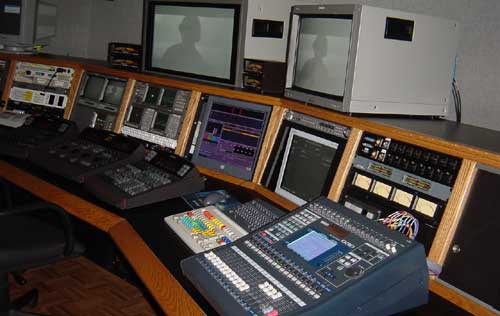
This image is of a modern setup, primarily computer-driven. With this kind of equipment, the telecine operator has an extraordinary range of tools at his or her disposal. As we'll discuss later, while a poor or hurried operator can produce garbage, skilled operators can do a lot to minimize the inherent tradeoffs in re-formatting film on video.
Let's dive in to the different formats, and what decisions are required to produce the video image you end up watching in your living room.
1.33:1 AR – Academy Standard
Up to now, this has been a complete no-brainer – 1.33:1 Academy Standard exactly matches the standard NTSC aspect ratio. The full image from the original film appears on screen without cropping, matting or letterboxing.
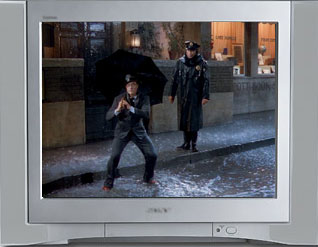
Of course, with the advent of widescreen digital and high-definition television broadcasting, these 4x3 images now require 'windowboxing' – placing bars on the sides of the image to fill out the full picture space. On many widescreen sets, the tuner automatically adds grey bars to the sides of any 4x3 image, looking like this:
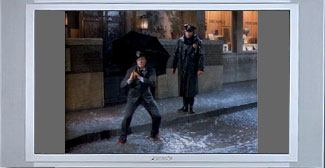
And, until the last few years, all television programming was also produced in the 4x3/1.33:1 format. More recently, some shows have started filming in the 16x9 digital widescreen format. While not really part of our film-to-video discussion, it does at least give me a chance to include an image from Mr. Show.
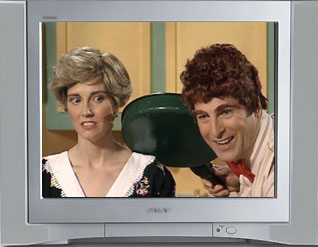
2.35:1 AR (Anamorphic – CinemaScope, Panavision), 70mm 2.20:1 AR, etc.
Now we start dealing with compromises. However, films in this group have the strongest claim for 'essential' letterboxing. Here's the original anamorphic (2.35:1 AR) image that Wes Anderson composed for The Royal Tenenbaums (2001):
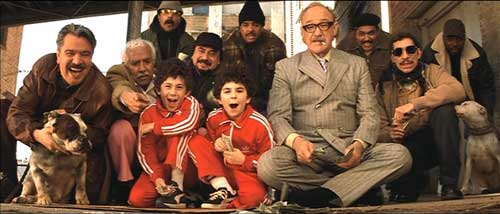
This extra-wide image is all we have to work with. Since the 4x3 image on standard televisions is much narrower, simply selecting a part of the image involves losing significant portions of the original image, and often ends up with a very unpleasant composition:
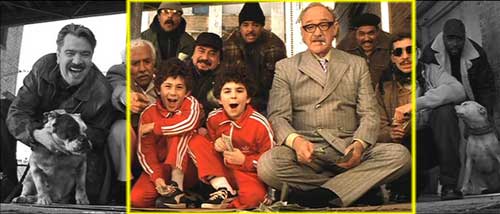
The 4x3 image produces a sense of claustrophobia in shots where the director has filled the frame with interesting content to examine. (Note that the dogs would be completely left out of this framing, making it less clear that the characters are watching a dog fight.)
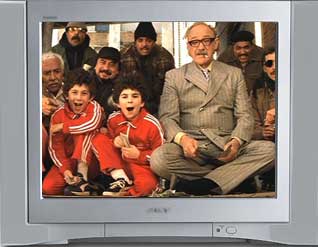
By letterboxing (taking the full image, placing it in the middle of the screen and adding black space at the top and bottom to fill out the picture), the full content of the scene is now clear. The extremely well-composed shot now can be seen as the director intended.
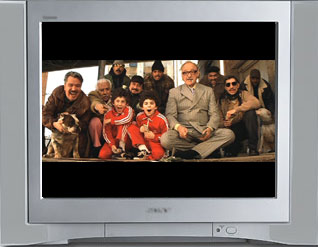
Here's my ultimate example of the problem. In Sergio Leone's The Good, The Bad and The Ugly (1966), the film ends with a climatic three-way showdown in a cemetery. Two of the three characters move to the extreme edges of the frame, producing a stunning composition – but a major problem in converting to home video.
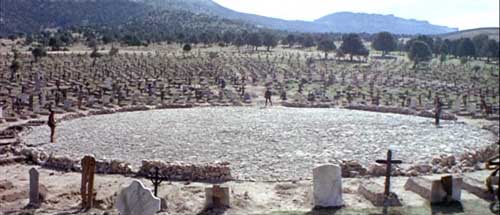
If you cut the sides off to fill the whole screen, it is impossible to keep all three characters on screen at the same time. Someone has to be left off. However, a clever telecine operator came up with a solution: 'pan' across the wide image, 'scanning' the image from left to right. For the images below, the operator would start from the left, and over a second or two move the 'window' from left to right, ending up at the opposite side.
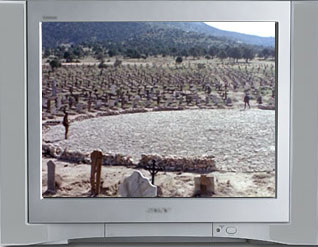
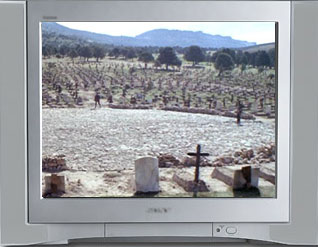
Earlier equipment wasn't capable of doing this in a way that looked like it was part of the film; as a result, 'panning and scanning' often produced a sequence that just felt wrong – out of place. (I call it 'visual dissonance'.) Modern equipment with high-end computing power can now produce telecine pans that are nearly indistinguishable from ones that were done by the camera operator.
However, even the best pan and scan job still is a compromise that keeps us from seeing the director's true visual composition. No pan and scan can make up for the loss of this iconic image:
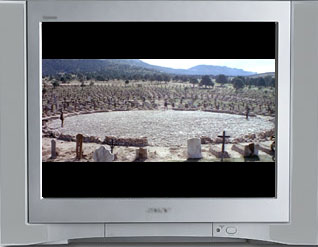
One more widescreen TV note: the digital broadcast standard for widescreen calls for a 16x9 AR screen. This is approximately 1.78:1. Since these widescreen images are 2.20:1 AR and wider, even widescreen sets require some amount of letterboxing to avoid cutting off the sides of the image.
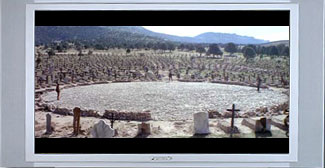
1.85:1 AR ('Flat')
Where Academy Standard (1.33:1 AR), 70mm (2.20:1 and higher AR) and anamorphic (2.35:1 AR) have a pretty simple 'ideal' solution across the board, the 1.85:1 'flat' format films introduce an incredible amount of variability to the mix. Let's start with a brief review of the 'flat' format.
'Flat' films are normally shot where the entire film frame is exposed:
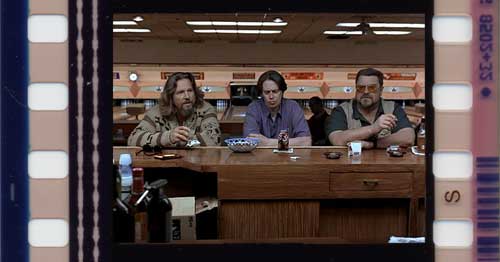
This produces a starting image that matches the Academy Standard (1.33:1 AR).
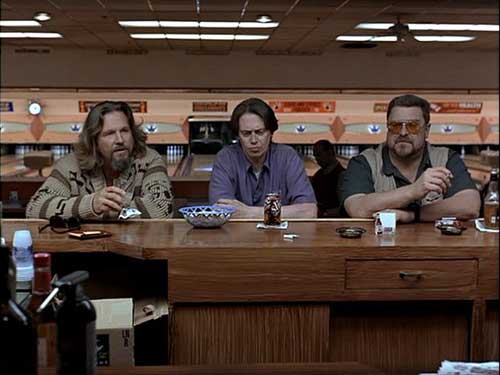
In the theater, the projector cuts off the top and bottom of the image with an aperture plate to produce a 'wider' image. In home video terms, blocking off this part of the image is referred to as 'matting'.
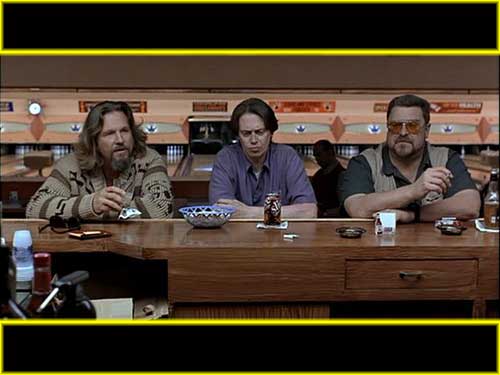
A technical note: there is no such thing as a 'letterboxed' Flat 35mm film on home video. Letterboxing refers to the process of filling in the missing area of a true widescreen image with filler (normally black space). Since Flat 35mm films are always based on a full frame of film, and therefore not really missing anything, all so-called 'letterboxed' Flat films are really 'matted' - meaning, the extra material is simply blocked off. So when the DVD case says: "WIDESCREEN FORMAT: Presented in a 'Matted' widescreen format preserving the aspect ratio of its original theatrical exhibition", you know that they're telling it like it really is.
Full-Frame Recomposing for Home Video
Pan and Scan – Selecting the 'Window'
The telecine operator has a lot of possible options in how they compose an image for standard televisions. In most cases, they end up panning and scanning within the 1.85:1 cropped/matted image area. There are a number of reasons for this: sometimes (as we discussed in Part 2), the director 'hard mattes' the image, only leaving the 1.85:1 image space to work in; and, frequently, there are items in the 'matted' area that are out of place or not appropriate to show on screen. Here are some examples of what this ends up looking like, starting with the 1.85:1 matted image.
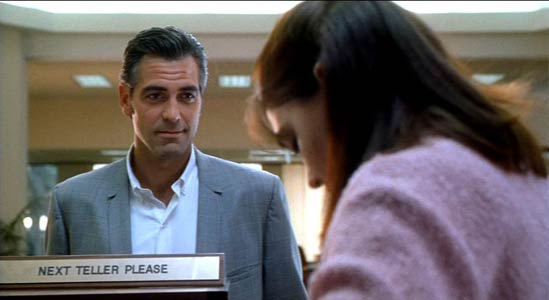
The operator selects the best compromise placement of the 4x3 window:
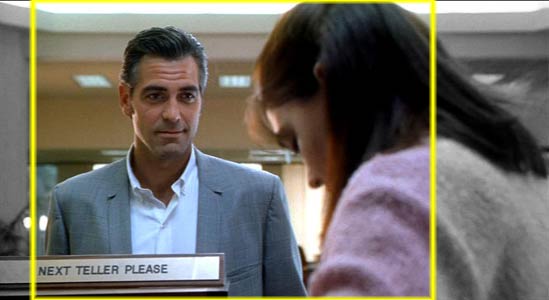
On the final product, a 'pan and scan' version and a 'matted' version of the same scene would look like this:
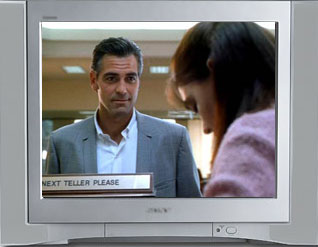
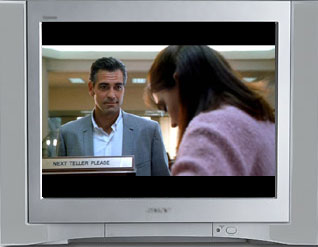
Panning and scanning (in the 1.85 image or in the true widescreen formats) becomes problematic when directors and cinematographers try to use the full width of the frame. In this case (from 1994's The Shawshank Redemption), action is taking place in two parts of the frame at the same time. If you try to get both actors at the same time, Morgan Freeman gets his arm cut off while throwing the ball.
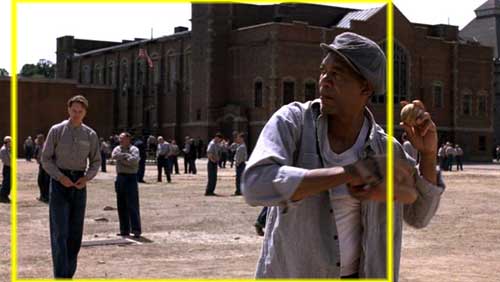
However, if you focus on Freeman, Tim Robbins gets cut out entirely.
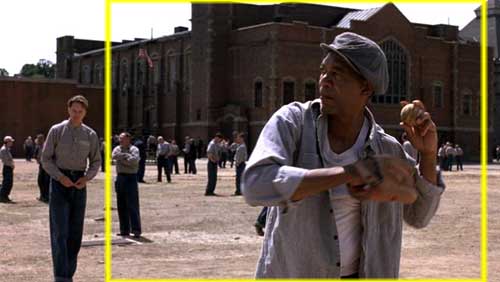
A common composition in many movies is the 'two shot', placing actors at the ends of the image while they exchange dialogue. Framing this down to 4x3 often produces uncomfortable cuts into the actors on the screen.
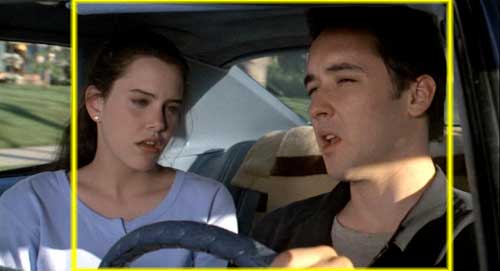
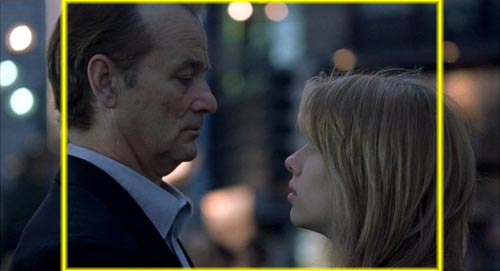
And, in this case, a 'three shot': with Scarlett Johansson the focal point in this scene, Anna Faris and Giovanni Ribisi end up being sliced in half to accommodate the reduced width.
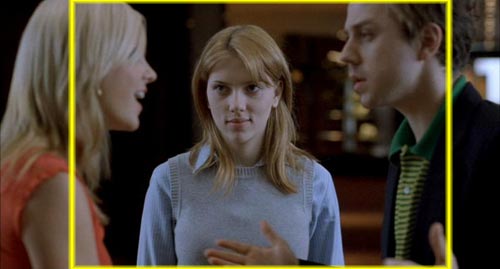
Open Frame
However……
Things are never simple when dealing with the Flat format. Here's an important idea to keep in mind: the 1.85:1 AR format is basically a 'hack' of the original Academy Standard (1.33:1 AR) format, and initially came about to allow movie studios in the 50's to release some of their 1.33:1 'backlog' in a faux-widescreen format. No matter how the image ends up in the theater, it always starts with a full 1.33:1 AR frame of film.
When composing the image in the camera, the operator refers to a series of marks in the viewfinder that define a 'safe area' that normally will not be shown when the film is projected in the theater. In traditional use, the safe zone is space where microphones, unfinished areas of special effects and wardrobe, and even assorted film technicians can 'safely' go without interfering with the projected image.
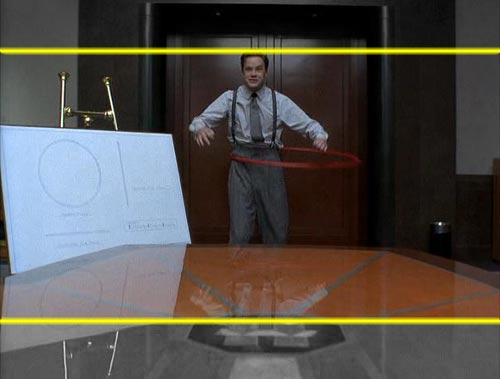
Again, when the extra space (usually matching the safe zone) is cropped out by the projector, it leaves the familiar widescreen image.
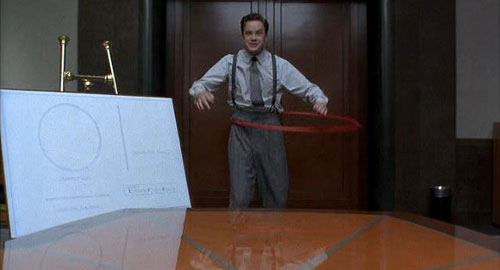
However, over the last several decades, many filmmakers, realizing the growing importance of home video (and that they may not be permitted to control the final video release), have treated the entire 1.33:1 image exposed in the camera as 'sacred'. They keep everything out of the safe zone entirely – no boom mics, no tennis shoe-wearing space monsters, no anything out of place.
What does this mean? In some cases, you can open up the full film frame and get 'more' image than you could see in the movie theater. It isn't necessarily what the director had intended, but it is often what the director had anticipated.
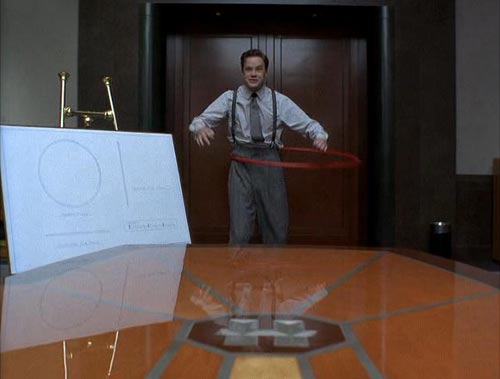
Note on this image: the logo on the table was cropped out to produce the 1.85:1 image in the theater, and would be blocked out in a matted home video release. Is the scene better with this extra material included or excluded? I think an argument could be made both ways (although my preference is for the matted version, which matches what I saw in the theater).
Super 35 (special 35mm format)
Along these lines, a number of directors have gone to a modified 35mm format known as Super 35. James Cameron, the most notable proponent of this approach, has gone on record stating that his preference is for the full-frame/4x3 versions of his Super 35 films on home video. Here is a quick visual demonstration.
Super 35 films start off in the camera with the image being exposed to the entire width of the film frame (up to the sprocket holes, overlapping the space normally resolved for the soundtrack). This produces an image that is wider than the 1.33:1 (1.37:1) AR space used in normal Flat photography. Here's a mocked-up example.
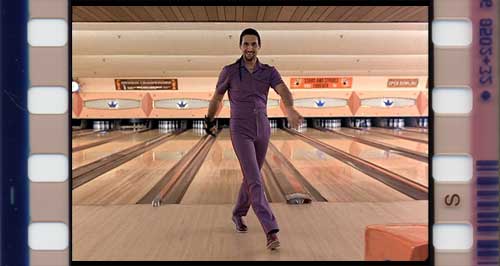
Then, to take this image and produce a theatrical print, the film lab selects the area required for the desired format (normally 2.35:1 anamorphic), placing it in the required spot on the print. Later, when the home video release is prepared, the 1.33:1 'window' is selected from this image. Here is a mockup of the image from above, using colors to show the different parts selected.
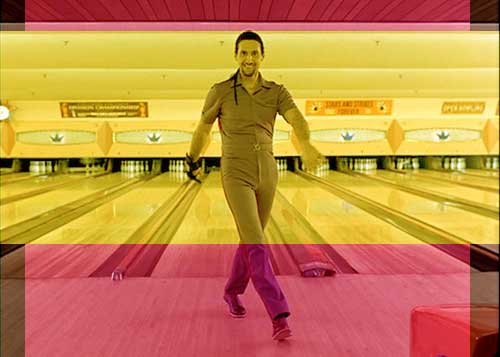
The yellow area shows the part selected for a 2.35:1 anamorphic film print, and the red shows the area selected for a full-frame (1.33:1/4x3) video release. To make this clearer, here are those selections as you would end up seeing them.
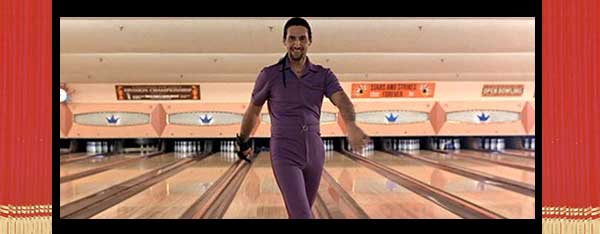
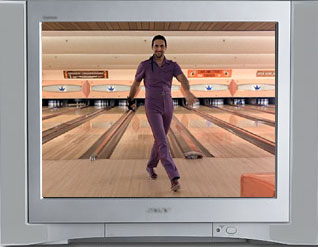
I should mention that some directors do use the Super 35 format for technical reasons not related to the full-frame home video release. For example, the format (compared to anamorphic) allows for a greater variety of camera lenses and can produce a greater depth of field. And Super 35 can also refer to the use of non-standard film frames (three perforations per frame, instead of the normal four on 35mm film), intended to keep a wide image while reducing wasted film stock.
Home Video – No Absolutes
Given the number of options presented to the telecine operator, it starts to become evident that the quality of a full-frame/pan-and-scan home video is dependent on a number of things: the care that was taken in composing the original image, the quality of the equipment used, the skill and experience of the operator, the instructions from the director (if they choose or are permitted to be involved), and, probably most of all, the time allotted. You can have the best of everything, but high-quality telecine formatting work takes a fair amount of time.
In most original aspect ratio discussions, the examples are almost always of home videos where the operator was rushed or just lazy. There are videos on the market where all they did was 'open up' the full frame, with no consideration of any problems in the safe areas. Boom mics, incomplete scenery, unfinished special effects – when allowed to appear on screen, these do indeed look ridiculous and amateurish. The opposite is also occasionally seen: a pan-and-scan video where the 'window' is set dead in the center of the widescreen image and never moves – even if the actors are no longer in the middle of the image.
However, there are some cases where the telecine operator can do remarkable work with the available materials – examining the full frame to select shots or scenes where 'opening up' is safe and allows for more material to be viewed, then shifting to carefully chosen 'windows' in the normal widescreen portion when the full frame is no longer 'clean' or available (such as on special effects shots). In these situations, the full-frame home video release may actually end up being a more satisfying experience for some.
As a devoted fan of everything about theatrical presentation of motion pictures, my personal preference in every case is to see a film on home video in a manner that replicates the theatrical experience. But, in our desire to bring others around to our perspective, falling into dogmatic repetitions of "Letterbox good, full-frame bad!" ends up producing serious confusion when they eventually see a film where the matted home video actually shows 'less' than the opened-up full-frame version.
Therefore, I'm going to close this ridiculously long article by summarizing what I feel is a realistic approach to the matter of home video and original aspect ratios.
-- Academy Standard: for standard televisions, there's no reason to even bother discussing this – the format fits the screen perfectly.
-- Anamorphic 35mm (CinemaScope, Panavision) and 70mm formats: given that there's no extra material to work with (height-wise), the only realistic argument against letterboxing these films on home video is on extremely small monitor sizes. (I once watched a letterboxed VHS [!] copy of Lawrence of Arabia on a 13 inch TV. It wasn't a pleasant experience.)
-- Hard-matted Flat 35mm prints: as with the widescreen formats listed above, there isn't any extra vertical material to possibly work with. So the same argument as above (in favor of matted home video release) still stands.
-- Soft-matted Flat and Super35 prints: this is where things break down. While my stated preference is to replicate the widescreen theatrical experience, in a number of cases full-frame home video releases can actually provide more material to view – and in some of those cases, that's exactly what the director intended. The problem is that, without researching the director and the film, you simply can't know.
So, with the exception of soft-matted Flat and Super35 films, the case is pretty solid. And even on those exceptions, taking the risk with a full-frame version of a Flat film means placing your viewing experience in the hands of the telecine operator, with all the variability involved. Conversely, purchasing the matted home video release means you will get a consistent result every time.
I guess my feeling is that I'd rather take the consistently solid product over the potentially better, but much more likely inferior, version. At least we're being provided with the option to choose. And isn't that what democracy is all about? (Yes, that's a weak ending. Sorry.)
Well, that's it. I hope you found something of value in this column. If you have any comments or questions, or have some suggestions for future topics, please drop me a line at the link shown below. Thanks.
Image Credits:
Singin' In The Rain (1951): © MGM
Mr. Show with Bob and David (TV, 1995): © HBO
The Royal Tenenbaums (2001): © Touchstone Pctures
The Good, The Bad and The Ugly (1966): © United Artists
The Big Lebowski (1998): © Polygram
Out of Sight (1998): © Universal Pictures
The Shawshank Redemption (1994): © Columbia Pictures
Say Anything (1989): © 20th Century Fox
Lost in Translation (2003): © Focus Features
The Hudsucker Proxy (1994): © Warner Bros.



































